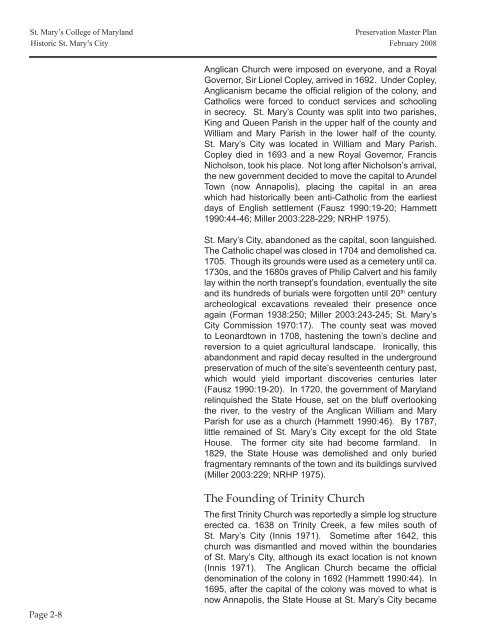St. Mary's College of Maryland Preservation Master Plan
St. Mary's College of Maryland Preservation Master Plan
St. Mary's College of Maryland Preservation Master Plan
- No tags were found...
Create successful ePaper yourself
Turn your PDF publications into a flip-book with our unique Google optimized e-Paper software.
<strong>St</strong>. Mary’s <strong>College</strong> <strong>of</strong> <strong>Maryland</strong><strong>Preservation</strong> <strong>Master</strong> <strong>Plan</strong>Historic <strong>St</strong>. Mary’s City February 2008Anglican Church were imposed on everyone, and a RoyalGovernor, Sir Lionel Copley, arrived in 1692. Under Copley,Anglicanism became the <strong>of</strong>ficial religion <strong>of</strong> the colony, andCatholics were forced to conduct services and schoolingin secrecy. <strong>St</strong>. Mary’s County was split into two parishes,King and Queen Parish in the upper half <strong>of</strong> the county andWilliam and Mary Parish in the lower half <strong>of</strong> the county.<strong>St</strong>. Mary’s City was located in William and Mary Parish.Copley died in 1693 and a new Royal Governor, FrancisNicholson, took his place. Not long after Nicholson’s arrival,the new government decided to move the capital to ArundelTown (now Annapolis), placing the capital in an areawhich had historically been anti-Catholic from the earliestdays <strong>of</strong> English settlement (Fausz 1990:19-20; Hammett1990:44-46; Miller 2003:228-229; NRHP 1975).<strong>St</strong>. Mary’s City, abandoned as the capital, soon languished.The Catholic chapel was closed in 1704 and demolished ca.1705. Though its grounds were used as a cemetery until ca.1730s, and the 1680s graves <strong>of</strong> Philip Calvert and his familylay within the north transept’s foundation, eventually the siteand its hundreds <strong>of</strong> burials were forgotten until 20 th centuryarcheological excavations revealed their presence onceagain (Forman 1938:250; Miller 2003:243-245; <strong>St</strong>. Mary’sCity Commission 1970:17). The county seat was movedto Leonardtown in 1708, hastening the town’s decline andreversion to a quiet agricultural landscape. Ironically, thisabandonment and rapid decay resulted in the undergroundpreservation <strong>of</strong> much <strong>of</strong> the site’s seventeenth century past,which would yield important discoveries centuries later(Fausz 1990:19-20). In 1720, the government <strong>of</strong> <strong>Maryland</strong>relinquished the <strong>St</strong>ate House, set on the bluff overlookingthe river, to the vestry <strong>of</strong> the Anglican William and MaryParish for use as a church (Hammett 1990:46). By 1787,little remained <strong>of</strong> <strong>St</strong>. Mary’s City except for the old <strong>St</strong>ateHouse. The former city site had become farmland. In1829, the <strong>St</strong>ate House was demolished and only buriedfragmentary remnants <strong>of</strong> the town and its buildings survived(Miller 2003:229; NRHP 1975).Page 2-8The Founding <strong>of</strong> Trinity ChurchThe first Trinity Church was reportedly a simple log structureerected ca. 1638 on Trinity Creek, a few miles south <strong>of</strong><strong>St</strong>. Mary’s City (Innis 1971). Sometime after 1642, thischurch was dismantled and moved within the boundaries<strong>of</strong> <strong>St</strong>. Mary’s City, although its exact location is not known(Innis 1971). The Anglican Church became the <strong>of</strong>ficialdenomination <strong>of</strong> the colony in 1692 (Hammett 1990:44). In1695, after the capital <strong>of</strong> the colony was moved to what isnow Annapolis, the <strong>St</strong>ate House at <strong>St</strong>. Mary’s City became
















